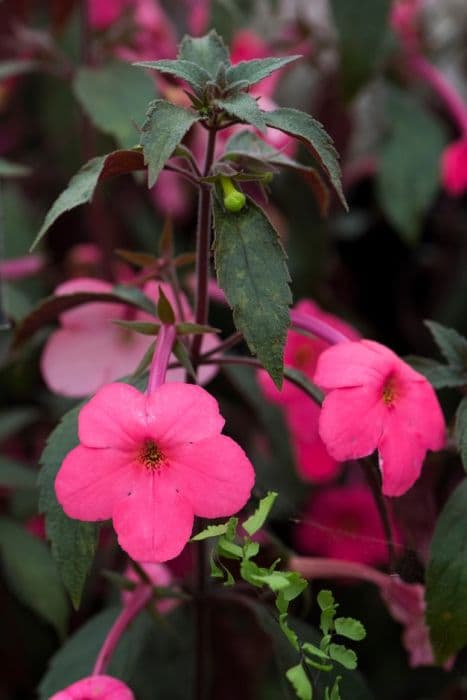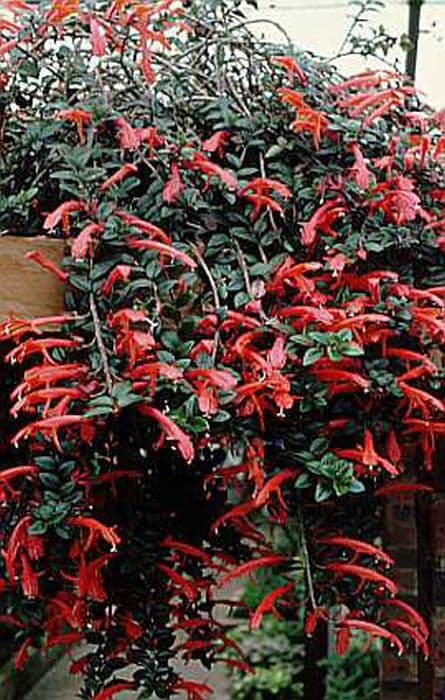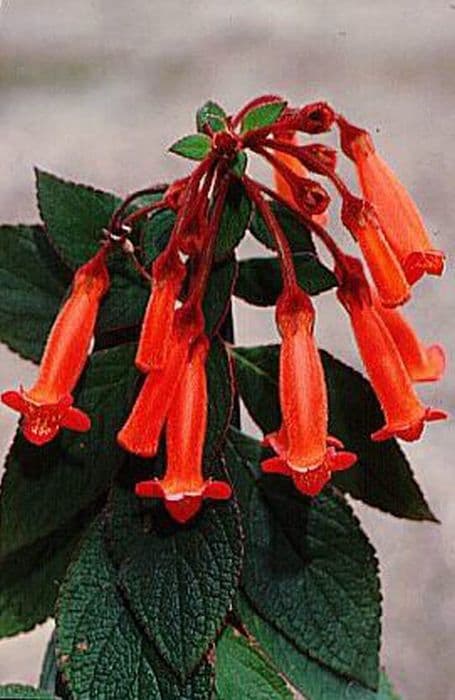Cape primrose 'Sioned' Streptocarpus 'Sioned'

ABOUT
'Sioned' is a medium-sized, perennial cultivar bearing white flowers from spring through to the autumn. The lower part of these funnel-shaped flowers are veined in magenta-pink, bleeding out to paler pink blotches. Strappy, evergreen leaves are softly hairy and wrinkled
About this plant
 Names
NamesFamily
Gesneriaceae
Synonyms
Cape Primrose, African Violet Cousin
Common names
Streptocarpus 'Sioned'.
 Characteristics
CharacteristicsLife cycle
Perennials
Foliage type
Evergreen
Color of leaves
Green
Flower color
Mixed
Height
1 foot (30 cm)
Spread
1 foot (30 cm)
Plant type
Herb
Hardiness zones
10
Native area
Africa
Benefits
 General Benefits
General Benefits- Easy to Care For: Streptocarpus 'Sioned', commonly known as Cape Primrose, requires minimal maintenance and can thrive indoors with proper light and water.
- Long Blooming Period: It produces flowers for a long period, often blooming continuously for months, which provides extended visual enjoyment.
- Variety of Colors: Cape Primrose is available in a variety of colors, allowing for personalization of indoor and outdoor spaces.
- Compact Size: Being a relatively small plant, it is well-suited for growing in tight spaces or small indoor areas.
- Attracts Pollinators: When placed outdoors, its flowers can attract beneficial pollinators like butterflies and bees.
- Non-Toxic: It is non-toxic to pets and humans, making it a safe choice for households with animals and children.
- Decorative Foliage: Aside from its flowers, Cape Primrose has attractive foliage that remains decorative even when the plant is not in bloom.
 Medical Properties
Medical PropertiesThis plant is not used for medical purposes.
 Air-purifying Qualities
Air-purifying QualitiesThis plant is not specifically known for air purifying qualities.
 Other Uses
Other Uses- Streptocarpus 'Sioned' can be used as a colorful addition to a terrarium environment, offering both visual appeal and a microclimate suited for other terrarium-friendly plants.
- The long-lasting flowers can serve as a temporary natural dye for fabrics when crushed, although results might be subtle and vary widely.
- Leaves of the Streptocarpus can be used in art projects, such as leaf printmaking, where their textures and patterns can be transferred to paper or other mediums.
- When included in educational settings, these plants are excellent for teaching botany and illustrating the lifecycle of angiosperms from flowering to seed production.
- Due to its compact size, Streptocarpus 'Sioned' is ideal for miniature gardens, providing a sense of scale and a burst of color without the need for large planting areas.
- The blooms of the Streptocarpus 'Sioned' could be used to make temporary, natural aquatic decorations in water bowls or small ponds, floating on the surface for events.
- Dried flowers can be incorporated into potpourri mixes to add color and mild fragrance to a room, combining with other herbs and flowers.
- Streptocarpus 'Sioned' can contribute to the aesthetics of a fairy garden, with its delicate flowers adding to the whimsical nature of the miniature setup.
- In photography, flowers of the plant can serve as an excellent object for macro photography practices, allowing one to capture intricate details of the petals and stigmas.
- During holiday seasons, the plant can be decorated with miniature ornaments to transform it into a living, festive display that complements seasonal decor.
Interesting Facts
 Feng Shui
Feng ShuiThe Cape primrose is not used in Feng Shui practice.
 Zodiac Sign Compitability
Zodiac Sign CompitabilityThe Cape primrose is not used in astrology practice.
 Plant Symbolism
Plant Symbolism- Persistence: Streptocarpus, also known as Cape Primrose, often symbolizes persistence due to its ability to bloom for long periods with proper care.
- Hope: The continuous blooming nature of Cape Primrose can represent hope, signaling that with time and care, better outcomes are possible.
- Endurance: As a plant that can thrive under various conditions, Cape Primrose represents endurance and the ability to overcome challenges.
- New Beginnings: The frequent blossoms of Cape Primrose are seen as a sign of new beginnings, renewal, and fresh starts.
 Water
WaterFor the Cape Primrose, it's vital to water it well when the surface of the soil feels dry to the touch, typically every 5 to 7 days depending on environmental conditions. Use room temperature water and avoid wetting the leaves to prevent fungal diseases; water from beneath or use a watering can with a long spout to direct water to the soil. A thorough watering that allows a little water to flow through the drainage holes is ideal, but be cautious not to leave the plant sitting in water. As a rough guideline, aim for about 8-16 ounces of water for a standard 6-inch pot, adjusting as necessary for your specific conditions and pot size.
 Light
LightThe Cape Primrose thrives in bright, indirect light; place it near a window where it can receive plenty of light without being exposed to the harsh midday sun. A north- or east-facing window is often ideal, offering the gentle light this plant prefers.
 Temperature
TemperatureThe Cape Primrose prefers temperatures between 60 to 75 degrees Fahrenheit and can tolerate a minimum temperature of 50 degrees Fahrenheit. To ensure healthy growth, keep the plant away from drafts and sudden temperature changes which can cause stress to the plant.
 Pruning
PruningPrune the Cape Primrose to remove spent flowers and yellowing leaves to encourage new growth and blooming. The best time for pruning is immediately after a bloom cycle has finished, which can be at various times throughout the year depending on the plant's environment.
 Cleaning
CleaningAs needed
 Soil
SoilCape Primrose requires a light, fast-draining soil mix with added perlite or vermiculite. A pH balance of around 6.0 to 7.0 is ideal for optimal growth.
 Repotting
RepottingCape Primrose should be repotted annually, preferably in spring or after it finishes blooming, to refresh the soil and provide room for growth.
 Humidity & Misting
Humidity & MistingCape Primrose thrives in high humidity, maintaining levels around 50-60% for optimal plant health and bloom production.
 Suitable locations
Suitable locationsIndoor
Place Cape Primrose in bright, indirect light and keep soil slightly moist.
Outdoor
Grow Cape Primrose in dappled shade; protect from afternoon sun.
Hardiness zone
10-11 USDA
 Life cycle
Life cycleCape Primrose 'Sioned' begins its life cycle when seeds germinate in warm, moist soil, typically taking between two to four weeks to sprout. The young seedlings then develop into a rosette of leaves, which gradually matures and begins to produce flowering stalks. These stalks can blossom in a variety of colors depending on the variety, with 'Sioned' producing blooms that persist for several weeks. After flowering, if the flowers are pollinated, the plant can produce seed pods that twist open to disperse seeds, completing the reproductive cycle. Even without pollination, Cape Primrose 'Sioned' can be propagated vegetatively by leaf cuttings, allowing for the creation of clone plants. Throughout its lifetime, which can be several years with proper care, 'Sioned' requires periods of growth and dormancy, with reduced watering in cooler months to simulate a natural environment.
 Propogation
PropogationPropogation time
Spring-Summer
Propogation: Streptocarpus 'Sioned', commonly known as Cape Primrose, is predominantly propagated through leaf cuttings. This method is popular because it is straightforward and effective. It's best to propagate in late spring or early summer when the plant is in its active growth phase. A healthy leaf should be chosen, preferably one that is neither too young nor too old. The leaf is cut across into sections, each with a vein, and then the sections are placed either directly into a potting mix or into a water medium to root. In the potting mix, they are placed vein-side down and lightly covered with soil; if water rooting is used, each piece should be suspended with the cut edge submerged. Rooting typically occurs in about four to eight weeks, after which individual plantlets will soon begin to form at the base of the cuttings. After a sufficient root system has developed, they can be potted individually into their own containers with a well-draining potting mix.









